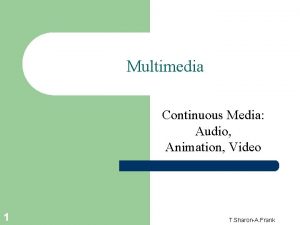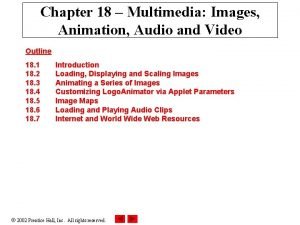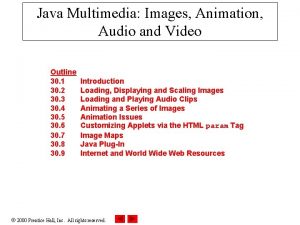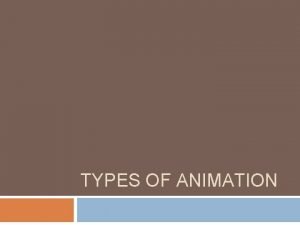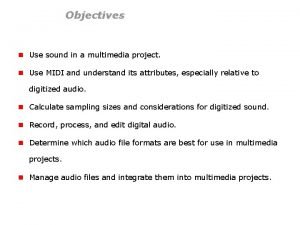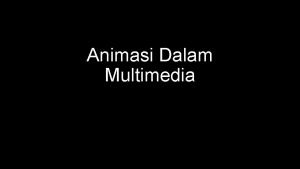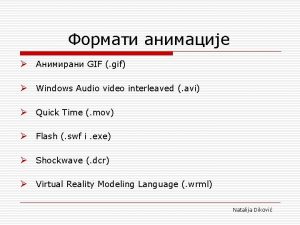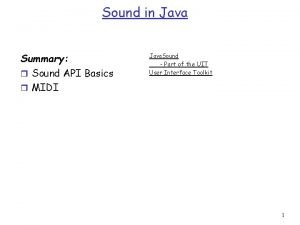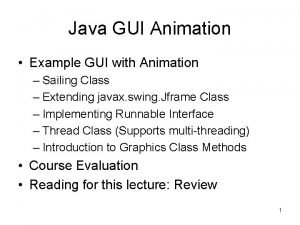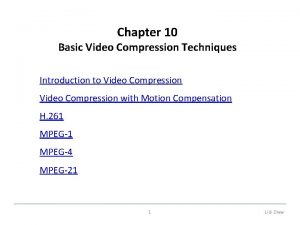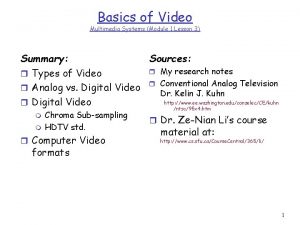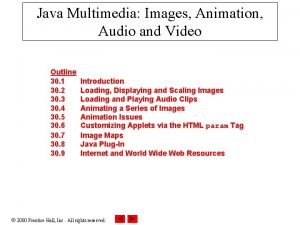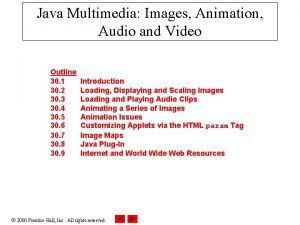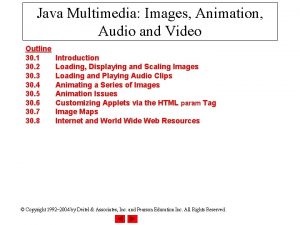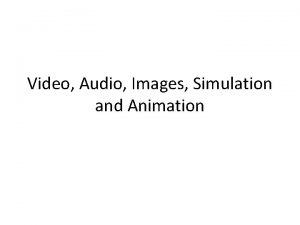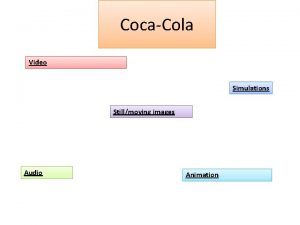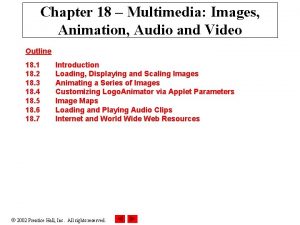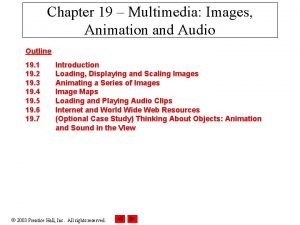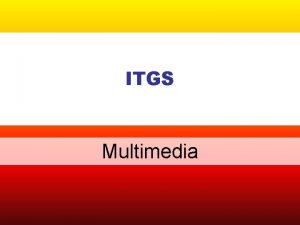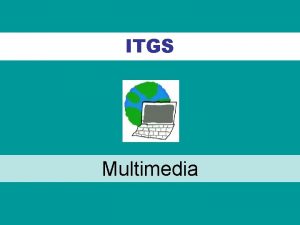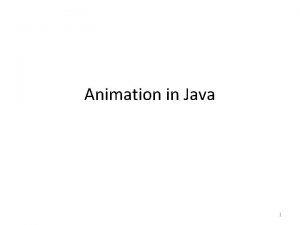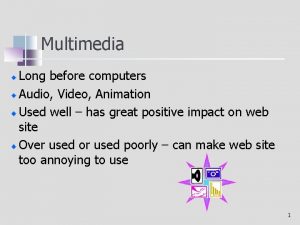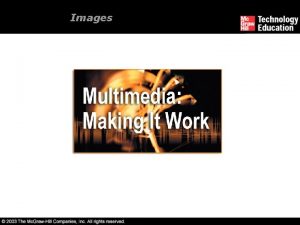Java Multimedia Images Animation Audio and Video Outline

















![32 if ( images[ current. Image ]. get. Image. Load. Status() == 33 Media. 32 if ( images[ current. Image ]. get. Image. Load. Status() == 33 Media.](https://slidetodoc.com/presentation_image/0bcee76c6db55ca6251ab1f79ad11714/image-18.jpg)







![33 images = new Image. Icon[ total. Images ]; 34 35 for ( int 33 images = new Image. Icon[ total. Images ]; 34 35 for ( int](https://slidetodoc.com/presentation_image/0bcee76c6db55ca6251ab1f79ad11714/image-26.jpg)











- Slides: 37

Java Multimedia: Images, Animation, Audio and Video Outline 30. 1 30. 2 30. 3 30. 4 30. 5 30. 6 30. 7 30. 8 30. 9 Introduction Loading, Displaying and Scaling Images Loading and Playing Audio Clips Animating a Series of Images Animation Issues Customizing Applets via the HTML param Tag Image Maps Java Plug-In Internet and World Wide Web Resources 2000 Prentice Hall, Inc. All rights reserved.

30. 1 Introduction • Revolution in computer industry – Before, computers used for high-speed calculations – Now, data manipulation important • Multimedia – "sizzle" of Java - images, sound, video – CDs, DVDs, video cards – Demands extraordinary computing power • Fast processors making multimedia possible • Java – Has built-in multimedia capabilities • Most programming languages do not – Develop powerful multimedia applications 2000 Prentice Hall, Inc. All rights reserved.

30. 2 Loading, Displaying and Scaling Images • Java Multimedia – Graphics, images, animations, sounds, and video • Begin with images • Class Image (java. awt) – Abstract class, cannot create an object directly • Must request that an Image be loaded and returned to you – Class Applet (superclass of JApplet) has this method • get. Image( image. Location, filename ); • image. Location - get. Document. Base() - URL (address) of HTML file • filename - Java supports. gif and. jpg (. jpeg) 2000 Prentice Hall, Inc. All rights reserved.

30. 2 Loading, Displaying and Scaling Images (II) • Displaying Images with draw. Image – Many overloaded versions g. draw. Image( my. Image, x, y, Image. Observer ); • my. Image - Image object • x, y - coordinates to display image • Image. Observer - object on which image is displayed – Use "this" to indicate the applet – Can be any object that implements Image. Observer interface – g. draw. Image( my. Image, x, y, width, height, Image. Observer ); • width and height - dimensions of image (automatically scaled) – get. Width(), get. Height() - return dimensions of applet 2000 Prentice Hall, Inc. All rights reserved.

30. 2 Loading, Displaying and Scaling Images (III) • Class Image. Icon – Not an abstract class (can create objects) – Example constructor private Image. Icon my. Icon; my. Icon = new Image. Icon( "my. Icon. gif" ); • Displaying Icons with method paint. Icon my. Icon. paint. Icon( Component, Graphics, x, y ) – Component - Component object on which to display image (this) – Graphics - Graphics object used to render image (g) – x, y - coordinates of Icon 2000 Prentice Hall, Inc. All rights reserved.

30. 2 Loading, Displaying and Scaling Images (IV) • Usage – Image. Icons are simpler than Images • Create objects directly • No need for Image. Observer reference – However, cannot scale Image. Icons • Scaling – Use Image. Icon method get. Image • Returns Image reference • This can be used with draw. Image and be scaled 2000 Prentice Hall, Inc. All rights reserved.

1 2 3 4 5 6 7 8 9 10 11 12 13 14 15 16 17 18 19 20 21 22 23 24 25 26 27 28 29 30 31 // Fig. 30. 1: Load. Image. And. Scale. java Outline // Load an image and display it in its original size // and scale it to twice its original width and height. // Load and display the same image as an Image. Icon. import java. applet. Applet; import java. awt. *; import javax. swing. *; Image Example public class Load. Image. And. Scale extends JApplet { private Image logo 1; private Image. Icon logo 2; 1. 1 Declare objects // load the image when the applet is loaded public void init() { logo 1 = get. Image( get. Document. Base(), "logo. gif" ); logo 2 = new Image. Icon( "logo. gif" ); } // display the image public void paint( Graphics g ) { // draw the original image g. draw. Image( logo 1, 0, 0, this ); // draw the image scaled to fit the width of the applet // and the height of the applet minus 120 pixels g. draw. Image( logo 1, 0, 120, get. Width(), get. Height() - 120, this ); 2000 Prentice Hall, the Inc. icon All rights reserved. // draw using its paint. Icon method 1. import 2. init() 2. 1 Initialize objects 3. paint() 3. 1 draw. Image calls

32 logo 2. paint. Icon( this, g, 180, 0 ); 33 } Outline 34 } 3. 2 paint. Icon call Program Output 2000 Prentice Hall, Inc. All rights reserved.

30. 3 Loading and Playing Audio Clips • Audio clips – Require speakers and a sound board – Sound engine - plays audio clips • Supports. au, . wav, . aif, . mid • Java Media Framework supports additional formats • Playing audio clips – play method in Applet – Plays clip once, marked for garbage collection when finished play( location, sound. File. Name ); location - get. Document. Base (URL of HTML file) play( sound. URL ); sound. URL - URL that contains location and filename of clip 2000 Prentice Hall, Inc. All rights reserved.

30. 3 Loading and Playing Audio Clips (II) • Playing audio clips – Method play from Audio. Clip interface – More flexible than Applet method play • Audio stored in program, can be reused – get. Audio. Clip • Returns reference to an Audio. Clip • Same format as Applet method play – get. Audio. Clip( location, filename ) – get. Audio. Clip( sound. URL ) – Once Audio. Clip loaded, use methods • play - plays audio once • loop - continuous loops audio in background • stop - terminates clip that is currently playing 2000 Prentice Hall, Inc. All rights reserved.

1 2 3 4 5 6 7 8 9 10 11 12 13 14 15 16 17 18 19 20 21 22 23 24 25 26 27 28 29 30 31 32 // Fig. 30. 2: Load. Audio. And. Play. java // Load an audio clip and play it. import java. applet. *; import java. awt. event. *; import javax. swing. *; public class Load. Audio. And. Play extends JApplet { private Audio. Clip sound 1, sound 2, current. Sound; private JButton play. Sound, loop. Sound, stop. Sound; private JCombo. Box choose. Sound; // load the image when the applet begins executing public void init() { Container c = get. Content. Pane(); c. set. Layout( new Flow. Layout() ); String choices[] = { "Welcome", "Hi" }; choose. Sound = new JCombo. Box( choices ); choose. Sound. add. Item. Listener( new Item. Listener() { public void item. State. Changed( Item. Event e ) { current. Sound. stop(); current. Sound = choose. Sound. get. Selected. Index() == 0 ? sound 1 : sound 2; } } 2000 Prentice Hall, Inc. All rights reserved. ); Outline 1. import 1. 1 Declare objects 2. init 2. 1 Set layout

33 c. add( choose. Sound ); 34 35 Button. Handler handler = new Button. Handler(); 36 play. Sound = new JButton( "Play" ); 37 play. Sound. add. Action. Listener( handler ); 38 c. add( play. Sound ); 39 loop. Sound = new JButton( "Loop" ); 40 loop. Sound. add. Action. Listener( handler ); 41 c. add( loop. Sound ); 42 stop. Sound = new JButton( "Stop" ); 43 stop. Sound. add. Action. Listener( handler ); 44 c. add( stop. Sound ); 45 46 sound 1 = get. Audio. Clip( 47 get. Document. Base(), "welcome. wav" ); 48 sound 2 = get. Audio. Clip( 49 get. Document. Base(), "hi. au" ); 50 current. Sound = sound 1; 51 } 52 53 // stop the sound when the user switches Web pages 54 // (i. e. , be polite to the user) 55 public void stop() 56 { 57 current. Sound. stop(); 58 } 59 60 private class Button. Handler implements Action. Listener { 61 public void action. Performed( Action. Event e ) 62 { 63 if ( e. get. Source() == play. Sound ) 2000 Prentice Hall, Inc. All rights reserved. 64 current. Sound. play(); Outline 2. 2 Add buttons 2. 3 Initialize audio clips 3. stop 4. Class Button. Handler

65 else if ( e. get. Source() == loop. Sound ) 66 current. Sound. loop(); 67 Outline else if ( e. get. Source() == stop. Sound ) 68 current. Sound. stop(); 69 } 70 } 71 } Program Output 2000 Prentice Hall, Inc. All rights reserved.

30. 4 Animating a Series of Images • Following example – Use a series of images stored in an array – Use same techniques to load and display Image. Icons • Class Timer – Generates Action. Events at a fixed interval in milliseconds Timer ( animation. Delay, Action. Listener ); Action. Listener - Action. Listener that will respond to Action. Events – Methods • start • stop • restart • is. Running 2000 Prentice Hall, Inc. All rights reserved.

30. 4 Animating a Series of Images (II) • Method repaint – Calls update, which calls paint. Component • Subclasses of JComponent should draw in method paint. Component • Call superclass's paint. Component to make sure Swing components displayed properly • View area – Width and height specify entire window, not client area – Dimension objects • Contain width and height values my. Dim. Object = new Dimension( 100, 200 ); my. Dim. Object. width 2000 Prentice Hall, Inc. All rights reserved.

30. 4 Animating a Series of Images (III) • get. Image. Load. Status – Image. Icon method • Determines if image is completely loaded into memory • Only complete images should be displayed (smooth animation) – If loaded, returns Media. Tracker. COMPLETE – Media. Tracker • Can determine when images are loaded, or force program to wait if not • Image. Icon creates our Media. Tracker for us 2000 Prentice Hall, Inc. All rights reserved.

1 2 3 4 5 6 7 8 9 10 11 12 13 14 15 16 17 18 19 20 21 22 23 24 25 26 27 28 29 30 31 // Fig. 30. 3: Logo. Animator. java // Animation a series of images import java. awt. *; import java. awt. event. *; import javax. swing. *; public class Logo. Animator extends JPanel implements Action. Listener { protected Image. Icon images[]; protected int total. Images = 30, current. Image = 0, animation. Delay = 50; // 50 millisecond delay protected Timer animation. Timer; public Logo. Animator() { set. Size( get. Preferred. Size() ); Outline 1. import 1. 1 implements Action. Listener 1. 2 Declare objects 1. 3 Constructor images = new Image. Icon[ total. Images ]; 1. 4 Initialize Image. Icon array for ( int i = 0; i < images. length; ++i ) images[ i ] = new Image. Icon( "images/deitel" + i + ". gif" ); 2. paint. Component start. Animation(); 2. 1 Call to superclass paint. Component } public void paint. Component( Graphics g ) { super. paint. Component( g ); 2000 Prentice Hall, Inc. All rights reserved.
![32 if images current Image get Image Load Status 33 Media 32 if ( images[ current. Image ]. get. Image. Load. Status() == 33 Media.](https://slidetodoc.com/presentation_image/0bcee76c6db55ca6251ab1f79ad11714/image-18.jpg)
32 if ( images[ current. Image ]. get. Image. Load. Status() == 33 Media. Tracker. COMPLETE ) { 34 images[ current. Image ]. paint. Icon( this, g, 0, 0 ); 35 current. Image = ( current. Image + 1 ) % total. Images; 36 } 37 } 38 39 public void action. Performed( Action. Event e ) 40 { 41 repaint(); 42 } 43 44 public void start. Animation() 45 { 46 if ( animation. Timer == null ) { 47 current. Image = 0; 48 animation. Timer = new Timer( animation. Delay, this ); 49 animation. Timer. start(); 50 } 51 else // continue from last image displayed 52 if ( ! animation. Timer. is. Running() ) 53 animation. Timer. restart(); 54 } 55 56 public void stop. Animation() 57 { 58 animation. Timer. stop(); 59 } 60 61 public Dimension get. Minimum. Size() 62 { 63 return get. Preferred. Size(); 2000 Prentice Hall, Inc. All rights reserved. 64 } Outline 2. 2 If image loaded, display it (paint. Icon) 2. 3 Increment current. Image 3. action. Performed 3. 1 start. Animation 3. 2 stop. Animation 3. 3 get. Minimum. Size

65 66 67 68 69 70 public Dimension get. Preferred. Size() { return new Dimension( 160, 80 ); } 71 public static void main( String args[] ) 72 73 { Logo. Animator anim = new Logo. Animator(); 74 75 76 JFrame app = new JFrame( "Animator test" ); app. get. Content. Pane(). add( anim, f. Border. Layout. CENTER ); 77 78 app. add. Window. Listener( 79 80 81 new Window. Adapter() { public void window. Closing( Window. Event e ) { 82 System. exit( 0 ); 83 84 85 86 87 88 89 90 } } ); // The constants 10 and 30 are used below to size the // window 10 pixels wider than the animation and // 30 pixels taller than the animation. app. set. Size( anim. get. Preferred. Size(). width + 10, 91 anim. get. Preferred. Size(). height + 30 ); 92 app. show(); 93 } 94 } 2000 Prentice Hall, Inc. All rights reserved. Outline 3. 4. get. Preferred. Size 4. main

Outline Program Output 2000 Prentice Hall, Inc. All rights reserved.

30. 5 Animation Issues • Storing images – Interlaced/non-interlaced formats • Specifies order in which pixels are stored • Non-interlaced - pixels stored in order they appear on screen – Image appears in chunks from top to bottom as it is loaded • Interlaced - pixels stored in rows, but of order – Image appears to fade in and become more clear • Animation flickers – Due to update being called in response to repaint – In AWT GUI components • Draws filled rectangle in background color where image was • Draw image, sleep, clear background (flicker), draw next image. . . – Swing's JPanel overrides update to avoid this 2000 Prentice Hall, Inc. All rights reserved.

30. 5 Animation Issues (II) • Double buffering – Used to smooth animations – Program renders one image on screen • Builds next image in off-screen buffer – When time to display next image, done smoothly • Partial images user would have seen (while image loads) are hidden • All pixels for next image displayed at once – Space/Time tradeoff • Reduces flicker, but can slow animation speed and uses more memory – Used by Swing GUI components by default 2000 Prentice Hall, Inc. All rights reserved.

30. 6 Customizing Applets via the HTML param Tag • Applets – Customize through parameters in HTML file that invokes it <html> <applet code="Logo. Applet. class" width=400 height=400> <param name="totalimages" value="30"> <param name="imagename" value="deitel"> <param name="animationdelay" value="200"> </applet> </html> – Invokes applet Logo. Applet – param tags • Each has a name and a value • Use Applet method get. Parameter (returns a String) parameter = get. Parameter( "animationdelay" ); 2000 Prentice Hall, Inc. All rights reserved.

30. 6 Customizing Applets via the HTML param Tag (II) • Following example – Use the Logo. Animator class as before, but modified slightly – Create Applet Logo. Applet • Takes parameters • Creates Logo. Animator object using the parameters • Plays animation 2000 Prentice Hall, Inc. All rights reserved.

1 2 3 4 5 6 7 8 9 10 11 12 13 14 15 16 17 18 19 20 21 22 23 24 25 26 27 28 29 30 31 32 // Fig. 30. 4: Logo. Animator. java // Animating a series of images import java. awt. *; import java. awt. event. *; import javax. swing. *; public class Logo. Animator extends JPanel implements Action. Listener { protected Image. Icon images[]; protected int total. Images = 30, current. Image = 0, animation. Delay = 50; // 50 millisecond delay protected String image. Name = "deitel"; protected Timer animation. Timer; public Logo. Animator() { initialize. Anim(); } // new constructor to support customization public Logo. Animator( int num, int delay, String name ) { total. Images = num; animation. Delay = delay; image. Name = name; initialize. Anim(); } private void initialize. Anim() 2000 { Prentice Hall, Inc. All rights reserved. Outline 1. import 1. 1 Logo. Animator class as before 1. 2 Constructor to allow customization
![33 images new Image Icon total Images 34 35 for int 33 images = new Image. Icon[ total. Images ]; 34 35 for ( int](https://slidetodoc.com/presentation_image/0bcee76c6db55ca6251ab1f79ad11714/image-26.jpg)
33 images = new Image. Icon[ total. Images ]; 34 35 for ( int i = 0; i < images. length; ++i ) 36 images[ i ] = new Image. Icon( "images/" + 37 image. Name + i + ". gif" ); 38 39 // moved here so get. Preferred. Size can check the size of 40 // the first loaded image. 41 set. Size( get. Preferred. Size() ); 42 43 start. Animation(); 44 } 45 46 public void paint. Component( Graphics g ) 47 { 48 super. paint. Component( g ); 49 50 if ( images[ current. Image ]. get. Image. Load. Status() == 51 Media. Tracker. COMPLETE ) { 52 images[ current. Image ]. paint. Icon( this, g, 0, 0 ); 53 current. Image = ( current. Image + 1 ) % total. Images; 54 } 55 } 56 57 public void action. Performed( Action. Event e ) 58 { 59 repaint(); 60 } 61 62 public void start. Animation() 63 { 2000 Prentice Hall, Inc. All rights reserved. 64 if ( animation. Timer == null ) { Outline 2. Methods as before

65 current. Image = 0; 66 animation. Timer = new Timer( animation. Delay, this ); 67 animation. Timer. start(); 68 } 69 else // continue from last image displayed 70 if ( ! animation. Timer. is. Running() ) 71 animation. Timer. restart(); 72 } 73 74 public void stop. Animation() 75 { 76 animation. Timer. stop(); 77 } 78 79 public Dimension get. Minimum. Size() 80 { 81 return get. Preferred. Size(); 82 } 83 84 public Dimension get. Preferred. Size() 85 { 86 return new Dimension( images[ 0 ]. get. Icon. Width(), 87 images[ 0 ]. get. Icon. Height() ); 88 } 89 90 public static void main( String args[] ) 91 { 92 Logo. Animator anim = new Logo. Animator(); 93 94 JFrame app = new JFrame( "Animator test" ); 95 app. get. Content. Pane(). add( anim, Border. Layout. CENTER ); 2000 Prentice Hall, Inc. All rights reserved. 96 Outline 2. Methods as before

97 app. add. Window. Listener( 98 99 100 101 102 new Window. Adapter() { public void window. Closing( Window. Event e ) { System. exit( 0 ); } 103 } 104 105 ); 106 107 108 app. set. Size( anim. get. Preferred. Size(). width + 10, anim. get. Preferred. Size(). height + 30 ); app. show(); 109 110 } } 111 // Fig. 30. 4: Logo. Applet. java 112 // Customizing an applet via HTML parameters 113 // 114 // HTML parameter "animationdelay" is an int indicating 115 // milliseconds to sleep between images (default 50). 116 // 117 // 118 // 119 // 120 // 121 // 122 // HTML parameter "imagename" is the base name of the images that will be displayed (i. e. , "deitel" is the base name for images "deitel 0. gif, " "deitel 1. gif, " etc. ). The applet assumes that images are in an "images" subdirectory of the directory in which the applet resides. 123 // HTML parameter "totalimages" is an integer representing the 124 // total number of images in the animation. The applet assumes 125 // images are numbered from 0 to totalimages - 1 (default 30). 126 2000 Prentice Hall, Inc. All rights reserved. Outline

127 import java. awt. *; 128 import javax. swing. *; 129 130 public class Logo. Applet extends JApplet{ 131 public void init() 132 { 133 String parameter; 134 135 parameter = get. Parameter( "animationdelay" ); 136 137 138 int animation. Delay = ( parameter == null ? 50 : Integer. parse. Int( parameter ) ); 139 140 String image. Name = get. Parameter( "imagename" ); 141 142 143 parameter = get. Parameter( "totalimages" ); int total. Images = ( parameter == null ? 0 : Integer. parse. Int( parameter ) ); 144 145 146 // Create an instance of Logo. Animator animator; 147 148 149 150 151 152 if ( image. Name == null || total. Images == 0 ) animator = new Logo. Animator(); else animator = new Logo. Animator( total. Images, animation. Delay, image. Name ); 153 154 set. Size( animator. get. Preferred. Size(). width, 155 animator. get. Preferred. Size(). height ); Hall, Inc. All rights reserved. 156 2000 Prentice get. Content. Pane(). add( animator, Border. Layout. CENTER ); Outline Applet 1. init 1. 1 Initialize objects from parameters 1. 2 Supply variables to constructor 2. Set layout

157 158 159 animator. start. Animation(); Outline } 160 } 2000 Prentice Hall, Inc. All rights reserved. 3. start. Animation

30. 7 Image Maps • Image map – Image that has hot areas • User can click to accomplish a task – Bubble help • When mouse over particular point in screen, small message displayed in status bar • In the following example – Load several images – Use event handler mouse. Moved to find x-coordinate – Based on the x-coordinate, display a message 2000 Prentice Hall, Inc. All rights reserved.

1 2 3 4 5 6 7 8 9 10 11 12 13 14 15 16 17 18 19 20 21 22 23 24 25 26 27 28 29 30 31 32 // Fig. 30. 5: Image. Map. java // Demonstrating an image map. import java. awt. *; import java. awt. event. *; import javax. swing. *; public class Image. Map extends JApplet { private Image. Icon map. Image; private int width, height; public void init() { add. Mouse. Listener( new Mouse. Adapter() { public void mouse. Exited( Mouse. Event e ) { show. Status( "Pointer outside applet" ); } } ); add. Mouse. Motion. Listener( new Mouse. Motion. Adapter() { public void mouse. Moved( Mouse. Event e ) { show. Status( translate. Location( e. get. X() ) ); } } ); map. Image = new Image. Icon( "icons 2. gif" ); 2000 Prentice Inc. All rights reserved. width Hall, = map. Image. get. Icon. Width(); Outline 1. import 1. 1 Declare objects 2. init 2. 1 add. Mouse. Listener 2. 2 Initialize Image. Icon

33 height = map. Image. get. Icon. Height(); 34 35 36 37 38 set. Size( width, height ); } public void paint( Graphics g ) { 39 3. paint map. Image. paint. Icon( this, g, 0, 0 ); 40 41 } 42 43 44 public String translate. Location( int x ) { // determine width of each icon (there are 6) 45 46 int icon. Width = width / 6; 47 48 49 if ( x >= 0 && x <= icon. Width ) return "Common Programming Error"; else if ( x > icon. Width && x <= icon. Width * 2 ) 50 Outline return "Good Programming Practice"; 51 52 else if ( x > icon. Width * 2 && x <= icon. Width * 3 ) return "Performance Tip"; 53 54 55 56 57 58 else if ( return x > icon. Width * 3 && x <= icon. Width * 4 ) "Portability Tip"; x > icon. Width * 4 && x <= icon. Width * 5 ) "Software Engineering Observation"; x > icon. Width * 5 && x <= icon. Width * 6 ) "Testing and Debugging Tip"; 59 60 return ""; 61 } 62 } 2000 Prentice Hall, Inc. All rights reserved. 4. translate. Location 4. 1 Display message depending on x

Outline Program Output 2000 Prentice Hall, Inc. All rights reserved.

30. 8 Java Plug-In • Web browsers – Many different browser versions – Most support Java 1. 0 and 1. 1, but few support Java 2 • Inconsistent support of 1. 1 – To use Java 2 in an applet, use the Java Plug-in • Bypasses browser's Java support • Installs complete version of Java Runtime Environment on user's computer • Large file - ideal for corporate intranets and high-speed networks 2000 Prentice Hall, Inc. All rights reserved.

30. 8 Java Plug-In (II) • Using the Plug in with applets – The <applet>, <param> and </applet> tags must be converted • Must indicate that Plug-in should be used to execute applet – Java Plug-in 1. 2 HTML Converter • Performs conversion for us • http: //java. sun. com/products/plugin/ – Execution • In install directory type java HTMLConverter • Select file to convert and type of conversion 2000 Prentice Hall, Inc. All rights reserved.

30. 9 Internet and World Wide Web Resources • Internet and web resources for Java Media Framework http: //java. sun. com/products/java-media/jmf/ • Download and documentation for JMF http: //java. sun. com/products/java-media/ jmf/for. Developers/ • Site for javax. media API descriptions • Downloadable image, audio, and video galleries – Test your multimedia programs http: //www. nasa. gov/gallery/index. html http: //sunsite. sut. ac. jp/multimed/ 2000 Prentice Hall, Inc. All rights reserved.
 Image is a continuous media.
Image is a continuous media. Animation audio video
Animation audio video Animation audio video
Animation audio video Traditional vs computer animation
Traditional vs computer animation Digital representation in multimedia
Digital representation in multimedia Sound editing operations in multimedia
Sound editing operations in multimedia Menggabungkan audio kedalam sajian multimedia
Menggabungkan audio kedalam sajian multimedia Definisi multimedia
Definisi multimedia What is animation in multimedia
What is animation in multimedia Pengertian audio video
Pengertian audio video Audio web video conferencing
Audio web video conferencing Audio video interleaved
Audio video interleaved Audio vs video
Audio vs video Audio untuk video pembelajaran
Audio untuk video pembelajaran Natalija dikovic
Natalija dikovic Multimedia linear and nonlinear
Multimedia linear and nonlinear Analog and digital video in multimedia
Analog and digital video in multimedia Pre production planning for video film and multimedia
Pre production planning for video film and multimedia Analog and digital video in multimedia
Analog and digital video in multimedia Quote sandwich paragraph example
Quote sandwich paragraph example Java audio api
Java audio api Java gui animation
Java gui animation Multimedia becomes interactive multimedia when
Multimedia becomes interactive multimedia when Csc253 interactive multimedia
Csc253 interactive multimedia Esa multimedia.esa.int./multimedia/virtual-tour-iss
Esa multimedia.esa.int./multimedia/virtual-tour-iss Video berasal dari bahasa latin yaitu vidi yang berarti
Video berasal dari bahasa latin yaitu vidi yang berarti How video works in multimedia
How video works in multimedia What is video shooting in multimedia
What is video shooting in multimedia Contoh bahan ajar multimedia interaktif
Contoh bahan ajar multimedia interaktif Digital representation in multimedia
Digital representation in multimedia Video compression techniques
Video compression techniques Types of video in multimedia
Types of video in multimedia Heanet filesender
Heanet filesender Yandex ru video search text video
Yandex ru video search text video Yahoo search video
Yahoo search video Twvideos
Twvideos The frame size of a video refers to the video’s
The frame size of a video refers to the video’s Multimedia elements graphics
Multimedia elements graphics
